 Some years ago, in a special issue of Japan’s Jazz Life magazine, they selected the 22 All-Time Greatest Jazz Guitarists. Legends like Charlie Christian, Django Reinhardt, Wes Montgomery, Kenny Burrell, and Jim Hall were included, of course, alongside more recent giants George Benson, Pat Martino, Larry Coryell, and John McLaughlin. Right there, amongst contemporaries John Abercrombie, Pat Metheny, John Scofield, and Bill Frisell, was Steve Khan! With nearly 30 recordings under his own name as a leader or co-leader, he has also produced recordings for fellow guitarists Larry Coryell, Mike Stern, Biréli Lagrène, and Bill Connors, as well as pianist Eliane Elias. In addition, he has published four highly regarded books: Wes Montgomery Guitar Folio, Pat Martino—The Early Years, and Khan’s own innovative instruction books Contemporary Chord Khancepts and Pentatonic Khancepts. While continuing to perform in clubs and concert halls worldwide, Steve has also become one of the most in-demand music clinicians and teachers.
Some years ago, in a special issue of Japan’s Jazz Life magazine, they selected the 22 All-Time Greatest Jazz Guitarists. Legends like Charlie Christian, Django Reinhardt, Wes Montgomery, Kenny Burrell, and Jim Hall were included, of course, alongside more recent giants George Benson, Pat Martino, Larry Coryell, and John McLaughlin. Right there, amongst contemporaries John Abercrombie, Pat Metheny, John Scofield, and Bill Frisell, was Steve Khan! With nearly 30 recordings under his own name as a leader or co-leader, he has also produced recordings for fellow guitarists Larry Coryell, Mike Stern, Biréli Lagrène, and Bill Connors, as well as pianist Eliane Elias. In addition, he has published four highly regarded books: Wes Montgomery Guitar Folio, Pat Martino—The Early Years, and Khan’s own innovative instruction books Contemporary Chord Khancepts and Pentatonic Khancepts. While continuing to perform in clubs and concert halls worldwide, Steve has also become one of the most in-demand music clinicians and teachers. You can read more about Khan on his very informative Web site, http://www.stevekhan.com/.
1. Which was the first record you bought with your own money?
That’s going back a lot of years—way too many years! As a kid, with my allowance, I think that the first single I bought was “Out of Sight” by James Brown. By the time that I earned some of my own money from working with my first professional band, I believe that I bought LPs like Tough Talk by the Jazz Crusaders, two Freddy King LPs, B.B. King’s Live at the Regal, and two Rolling Stones LPs. One must remember that, in those days, an LP cost $2! A $20 bill went a long, long ways!
2. Which was the last record you bought with your own money?
Believe it or not, I had to buy another copy of the soundtrack for the Coen Brothers film, O Brother, Where Art Thou? The song “I’ll Fly Away”—sung by Alison Krauss—was playing somewhere, and I was reminded about all those wonderful songs in the film. Thinking that I had this recording, I went searching through my iTunes library, and found nothing. Then I went searching through all my CDs, and found nothing. And then it all came back to me. I had given my CD of that recording to a great love of mine in Venezuela. So, I ordered a new copy from amazon.com. When it arrived, I must have listened to “Down to the River to Pray” by Alison Krauss 200 times—almost without stopping.
I can’t explain why I find that song so moving, I want to view it as a “spiritual” song, and not a “religious” song—because such things are completely antithetical to everything that makes up my personal belief system. But I just find that song to be deeply, deeply moving!
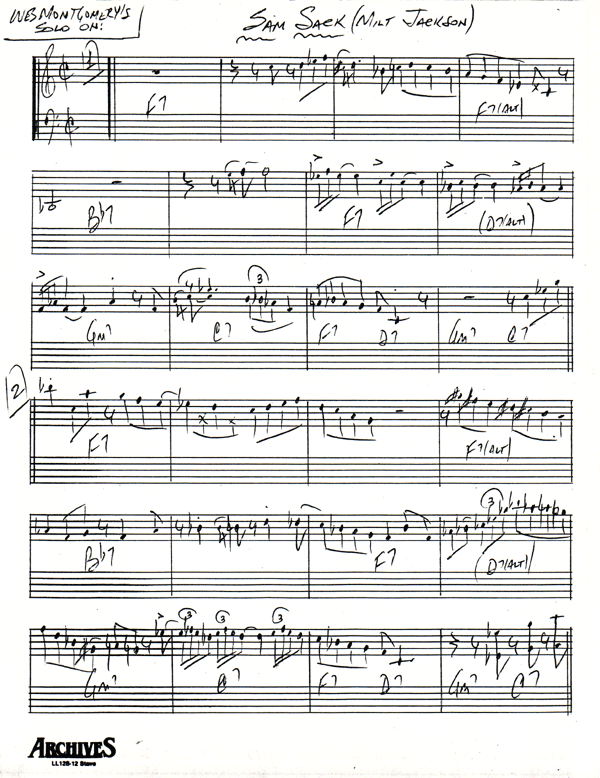
"Sam Sack"
Wes Montgomery solo over the song by Milt Jackson from BAGS MEETS WES(Riverside).
Transcription and analysis, Steve Khan.
MP3 file: samsack.mp3 (935k)
3. What was the first solo you learned from a record — and can you still play it?
Probably something by Freddy King. I always loved “Heads Up” and “Sen-Sa-Shun.” I know them both, but I’d have to practice them now to remember them. “Heads Up” is a little easier to remember. I think that I could do it now!
4. Which recording of your own (or as a sideman) are you most proud of, and why?
As the years have come and gone, and my good fortune in having recorded so many times as an artist becomes more clear, I too see it all as one body of work—an elongated process of struggle and growth—slow though it might have been. When I can get past the painful aspects of each recording—sometimes the process is just too much for me.
However, I have very special feelings for Eyewitness [1981] because it was the first recording with Anthony Jackson, Steve Jordan, and Manolo Badrena. It marked a pivotal moment in my development and I owe those three players so much! I have very warm feelings for Crossings [1994] as well. The overall sound is just so beautiful to me. That was with Anthony Jackson, Dennis Chambers, and Manolo Badrena—and Michael Brecker appeared on three tunes. Finally, The Suitcase [2008], a double-live CD, recorded in May of 1994 with Anthony Jackson and Dennis Chambers. It is perhaps the best representation of how we went about making music together. The “together” aspect means more to me than anything else.
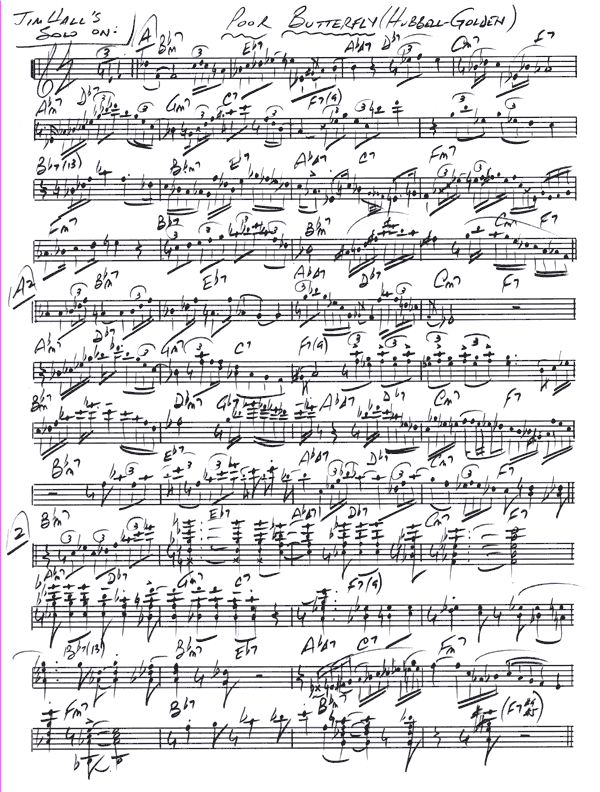
"Poor Butterfly"
Jim Hall solo over the Hubbell-Golden song from GLAD TO BE UNHAPPY(RCA/BMG).
Transcription and analysis, Steve Khan.
MP3 file: poorb.mp3 (2.4MB)
5. What's the difference between playing live and playing in a studio?
One can be beautiful, inspiring, and exhilarating because of the immediacy. The other, even with the very same rhythm section, is almost always, for me, an exercise in self-torture. I don’t enjoy listening to myself, and at times it’s very painful to be so confronted with your very own mediocrity—to have it right there, in your face! But one gets past that, somehow, just does the work, and recordings get done.
6. What's the difference between a good gig and a bad gig?
A bad gig is anything that you did for the money. A good gig is one that you would have done for nothing. When you’re playing for the love of the music—for the joy of making that particular music with your bandmates—there is no better gig, no better feeling than that.
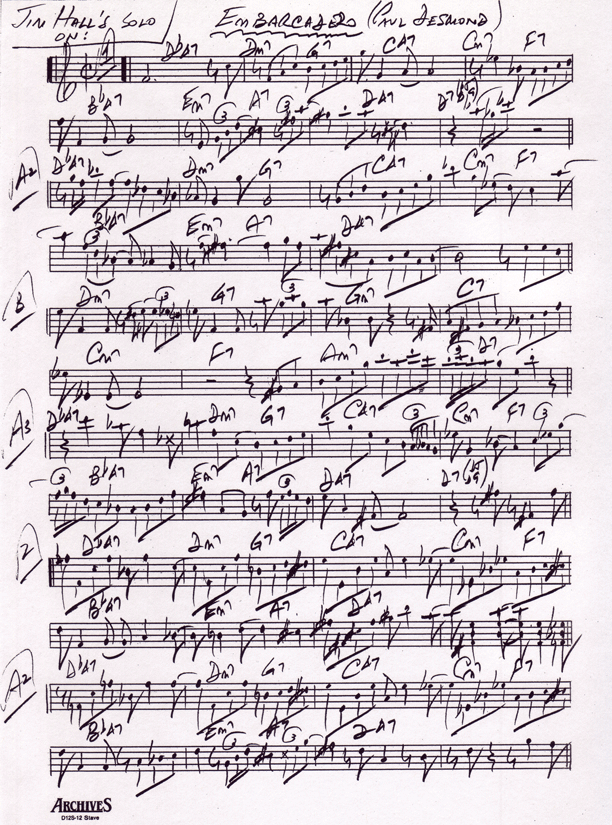
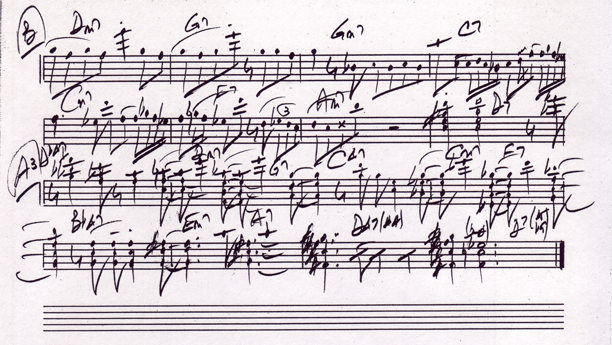
"Embarcadero"
Jim Hall solo, over the tune by Paul Desmond. From Desmond's TAKE TEN(RCA).
Transcription and analysis, Steve Khan.
MP3 file: hall.mp3 (1.4MB)
7. What's the difference between a good guitar and a bad guitar?
Bad guitars—I simply avoid them like the plague! A good guitar is one that you have chosen to play and, after having done that, you have had some work done on it to make certain that it is properly set-up for your touch and what feels natural for you. Everyone’s touch on their instrument is so personal, so individual. As one continues to grow as a player, you realize just how personal it really is. So, a bad guitar is simply one that has not been set-up properly for me, or can’t be adjusted at all.
8. You play electric and acoustic. Do you approach the two differently?
In a sense, yes. But, I try to make all my instruments feel the same. They are all strung-up very light—and people are often shocked by just how “easy” they are to play. And they can be shocked by how I can produce a warm tone, and a big, round sound with such light strings. I’ve been adjusting my touch my whole professional life in order to be able to do this. It’s always a work in progress for me. On my acoustic steel-string, I use a plain G-string. Most times a .016 or a .017. I like to have that kind of twangy, elastic feeling to the G-string. I feel “at home” that way.
I would hope that I sound like I am approaching the 3 instruments—electric, acoustic steel-string, and nylon-string—differently. I play the songs that I choose to play with the same love, commitment, or intensity, no matter what the instrument might be.
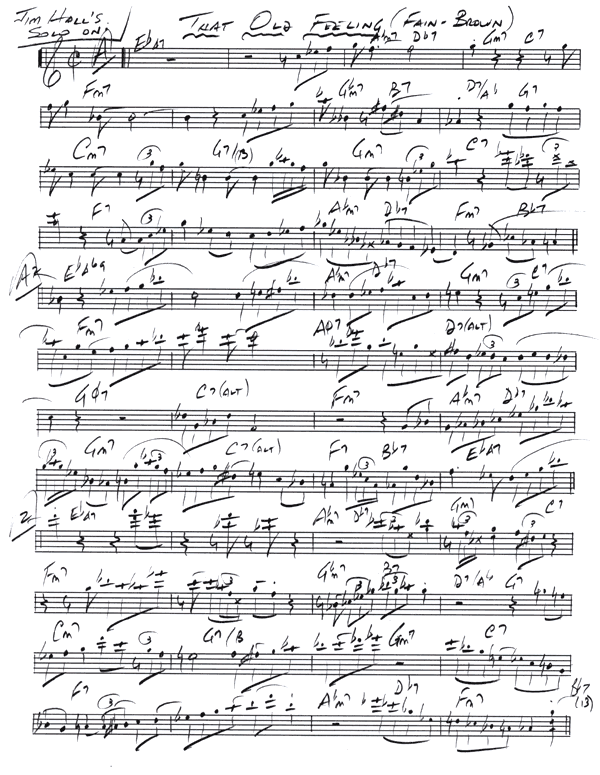
"That Old Feeling"
This Jim Hall solo from Paul Desmond's '63 recording, EASY LIVING(RCA) gives Steve "that old feeling" as he sings the praises of one of his earliest heroes.
Transcription and analysis, Steve Khan.
MP3 file: feeling.mp3 (2.5MB)
9. Do you sound more like yourself on acoustic or electric?
I think that I have come to sound like “myself”—whatever others hear that as—on both instruments, but it certainly did not happen overnight!
10. Do you sound like yourself on other people's guitars?
No! Absolutely not! I would never even attempt to play someone else’s guitar. They always feel terrible to me, impossible to play, no matter how much I might respect and admire that person’s playing. Heavier strings, higher action? This becomes impossible for me.
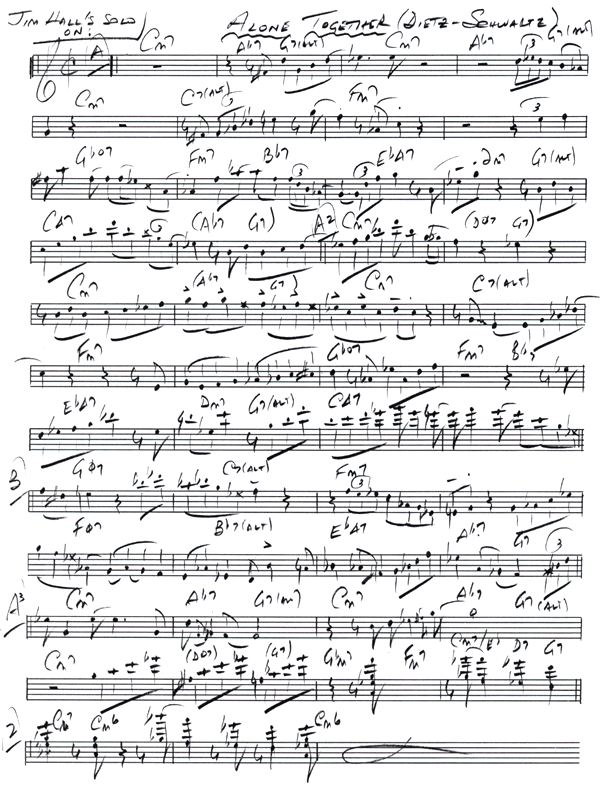
"Alone Together"
Another Jim Hall solo gem, over this well-known and oft-played standard. Also from Paul Desmond's TAKE TEN(RCA).
Transcription and analysis, Steve Khan.
MP3 file: alonetogether.mp3 (1.2 MB) | alonetogether.rm (605k)
11. Which living artist would you like to collaborate with, and why?
Well, when you use a word like “collaborate” I take that to mean a joint effort to create something together—as equals. It’s much easier to conceive of, or think of such a thing than to actually execute it, unless there is an intense desire on the part of both artists. Honestly, I rarely if ever even think about such things now. When I was younger, much younger, I constantly dreamed of working together with countless artists, all the usual heroes, the obvious, and the obscure.
That said, I have often thought that it would be wonderful to do something together with Paul Franklin, the fantastic pedal-steel player from Nashville. I love his playing, and the fact that he seems to have an excellent feel for textures. That would be huge for me.
On a completely different note, I did everything within my humble powers to try to get Brazilian vocalist, Gracinha Leporace, to sing a couple of the vocalese sections that appear on my forthcoming recording. No matter how hard I tried, how noble my effort was, I could not get this to happen. It will always remain a great, great personal disappointment for me. No one sings like her!
12. Which dead artist (music, or other arts) would you like to have collaborated with, and why?
Again, my perspective from this latter stage of life is very, very different than from my youth. In the past, I could have easily inserted myself—with the help of my imagination—my vision of how I might have played in any of the recordings that changed my life. That includes Jazz, RandB, Rock, Folk, World, etc.! But now? I see those recordings, those moments, as perfect, perfect in time, and I would change nothing about any of them.
If I could have been Steve Cropper and played all those fantastic guitar parts on my favorite RandB songs—how great would that have been? If I could have been Jimmy Nolen and played on all the great James Brown songs—how great would that have been? If I could have played with Larry Young around the time of Unity. I suppose, if I had been ready for that, I would have given anything to have been part of that vibe.
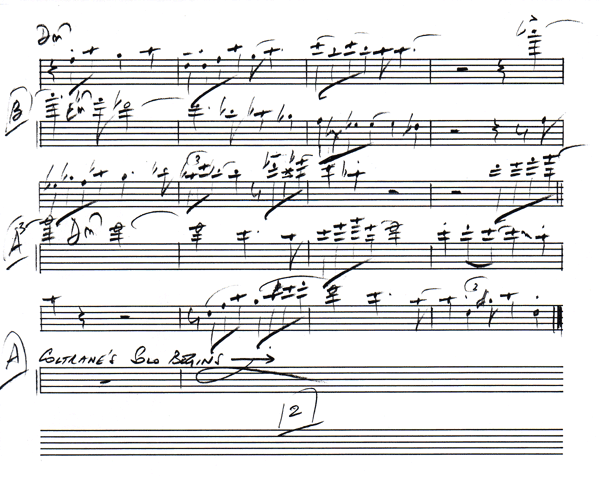
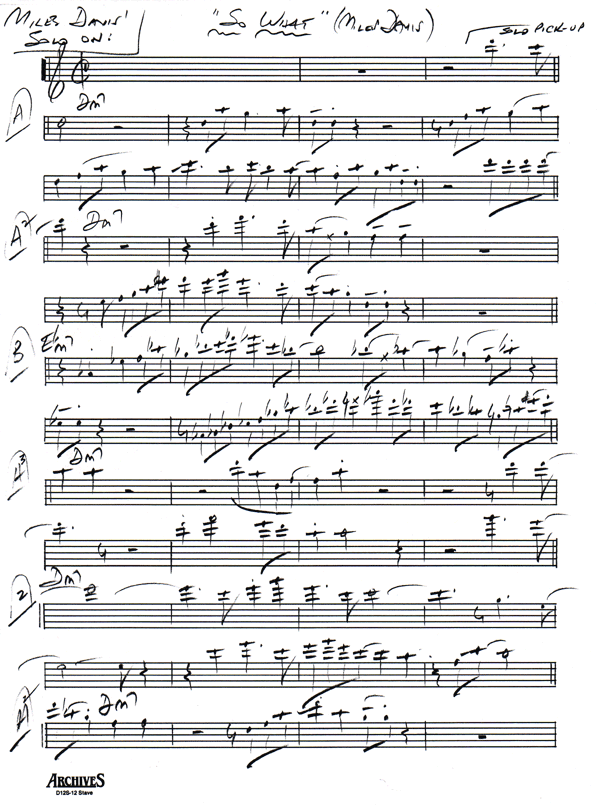
"So What"
A truly classic Miles Davis solo from his 1959 recording, KIND OF BLUE (Columbia).
Considered by many as the greatest Jazz recording ever, we offer a look into Miles' brilliantly minimalist approach to modal playing.
Transcription and analysis, Steve Khan.
MP3 file: sowhat.mp3 (2.1MB) | sowhat.rm (1.6MB)
13. What's your latest project about?
Parting Shot (Golpe de Partida) reunites me with five of my favorite musicians on this planet—Anthony Jackson, Dennis Chambers, Manolo Badrena, Marc Quiñones, and Bobby Allende. Guest artists include Rob Mounsey, Tatiana Parra, and Andrés Beeuwsaert. This is the kind of Latin Jazz recording that I have always dreamed about making, but I just wasn’t prepared enough to have done it before. It’s an attempt to combine the looseness—the spaciness of the way we made music as Eyewitness—with many of the traditional rhythms that make up the glorious genre of Latin music.
In all honesty, I don’t know that I’ll ever be able to record again. So, the joy of just being able to do this recording now is tempered and tinged with a great sadness over the realities that I face—that all artists face—within the current climate of the “business of music.” I am, in no way, speaking of the state of my health. I’m fine, as far as I know.
A must visit FULL of real great scores & transcription